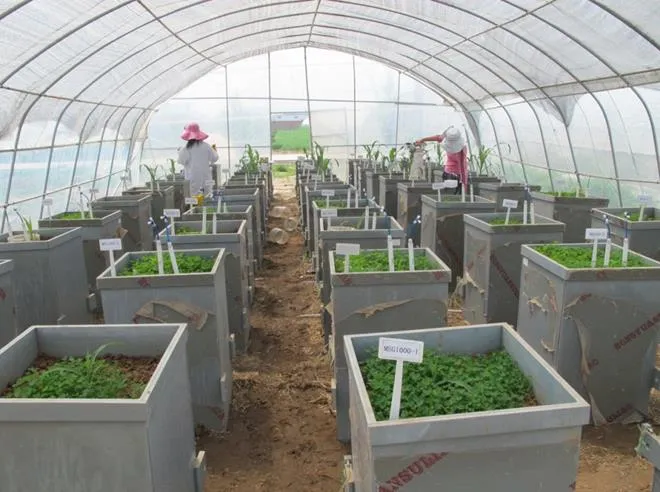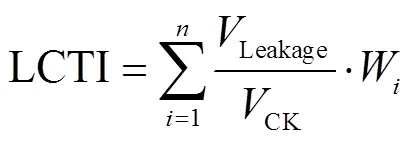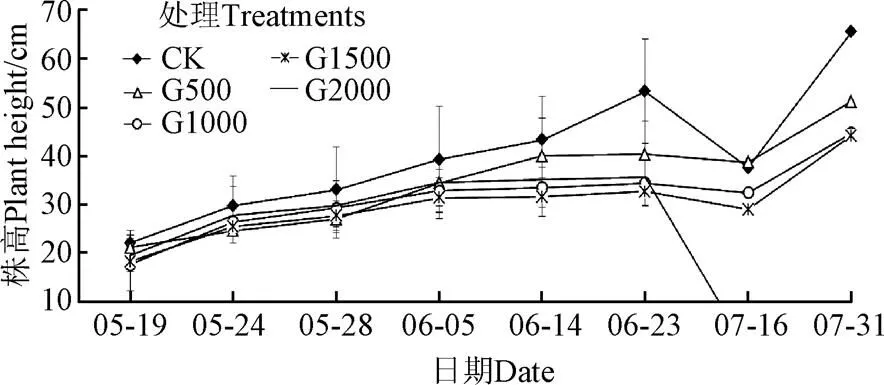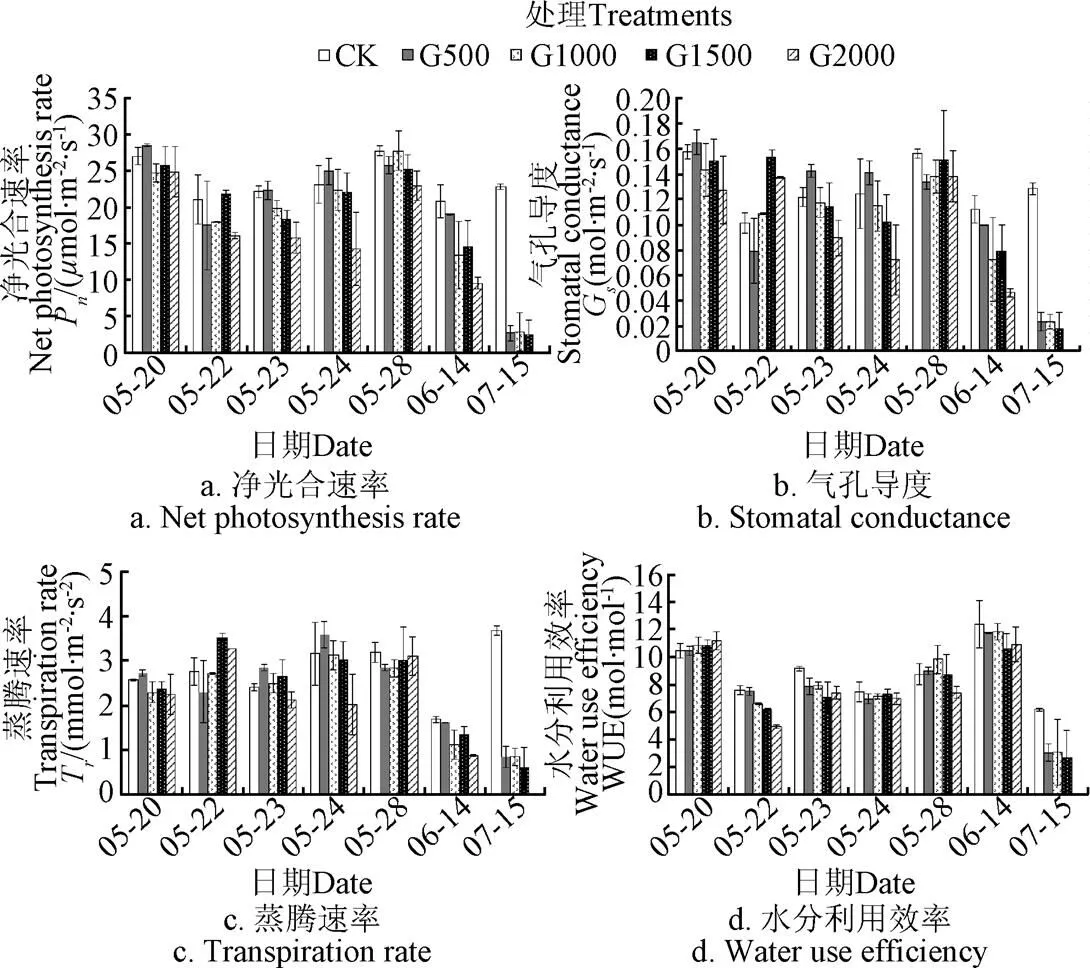大刍草作为地质封存CO2泄漏指示植物的评估
马 欣,张雪艳,田 地,何霄嘉,韩耀杰,纪 翔
大刍草作为地质封存CO2泄漏指示植物的评估
马 欣1,张雪艳2,3※,田 地4,何霄嘉5,韩耀杰1,纪 翔1
(1. 中国农业科学院农业环境与可持续发展研究所,北京 100081;2. 中国科学院地理科学与资源研究所,北京 100101;3. 中国科学院农业政策研究中心,北京 100101;4. 北京大学城市与环境学院,北京 100871;5. 中国21世纪议程管理中心,北京 100038)
随着神华集团鄂尔多斯全球第一个全流程CO2盐水层封存项目进入长期监测与预警业务流程,选择适宜的CO2泄漏指示植物方法和试验十分紧迫,但相关的认识还存在不足。采用新发展的植物对CO2泄漏耐受指数方法,通过盆栽模拟CO2泄漏的试验,以广泛种植的人工牧草大刍草为例,系统评估大刍草对封存CO2泄漏的耐受能力。结果发现:随着封存CO2泄漏量的增加,大刍草株高呈下降趋势,生物量下降在70%以上。大刍草的耐受指数为0.26,属于较不耐受,没有达到CO2泄漏指示性植物的标准,需要进一步扩大筛选范围。该文初步验证了耐受指数方法在筛选地质封存CO2泄漏指标植物的适用性。同时,为增强地质封存CO2泄漏指示植物筛选的稳健性,建议未来加强对植物栽培管理措施、全生长周期等的综合评估。
植物;试验;评估;CO2封存;泄漏;大刍草
0 引 言
碳捕集与封存可将主要工业源排放的CO2封存在稳定的地质结构中,包括注入到盆地的石油与天然气储层、深层咸水层和不可开采的煤层等,特别是盐水层封存具有巨大的减排潜力[1]。2016年,由神华集团建设的全球第一个全流程盐水层封存工程——鄂尔多斯30万吨煤制油工程高浓度CO2捕集与封存工程完成,封存深度约700 m,已进入长期监测与预警业务流程[2]。为了确保地质封存CO2的安全性,及时发现跨越盖层、水力圈闭逃逸至土壤层的CO2泄漏,地表植被响应作为重要的预警指标,已经引起广泛的关注[3-4]。
已有研究揭示了玉米出苗、株高和生物量受到浅层泄漏CO2的严重阻碍[5-6],春蚕豆的豆荚数量和干重下降了36%~65%[7],表明部分农作物易受到封存CO2泄漏的影响。而有试验发现三叶草能耐受500 g/(m2·d)的CO2泄漏强度[8-9],揭示出不同植物的耐受性存在一定的差异。因此,为深入认识植物对封存CO2泄漏的响应,更多的植物需要纳入到测试范围中[10]。
地质封存风险可以通过观察对CO2泄漏敏感的植物表征进行预警[11-12]。Beaubien等[13]调查意大利Latera地区的天然CO2释放点的植物表现,发现在中心区域没有植物存活,在释放点周边土壤CO2浓度40%的区域生长耐酸性植物L.,在离释放中心6 m远的区域生长着三叶草。West等[14]发现在土壤60 cm深度通入1 L/min CO2后,牧草在试验区域占据主导地位,表现出较好的耐受性。尽管相关案例研究已有一定的积累,但植物对CO2泄漏耐受能力的定量评估还不多[15-16]。在农业领域,有大量关于植物对环境胁迫的研究,比如干旱、洪涝、冷害和盐碱等[17-21]。兰巨生等[22]发展的干旱耐受指数被广泛应用于抗旱作物的育种。因此,发展可靠的封存CO2泄漏的耐受指数对指示植物的筛选具有重要意义[23-24]。
目前,鄂尔多斯盐水层封存工程没有发现CO2泄漏到地表的现象[2],但为应对未来可能发生的泄漏风险,需要在工程现场种植适宜当地气候、对封存CO2泄漏敏感的指示性植物,发挥地表植物的预警作用。大刍草是优良的人工牧草品种,属于禾本类假蜀黍属,全年可多次刈割,亩产鲜草10 t以上,是牧区优质的牛、羊饲料[25]。大刍草根系发达、茎杆粗壮、直径1.5~2.0 cm,高约1.5~3.0 m,对环境胁迫的影响易于观察[26]。本文通过发展植物对封存CO2泄漏的耐受指数方法,以盆栽模拟地质封存CO2泄漏,评估大刍草对封存CO2泄漏的响应,为鄂尔多斯CO2盐水层封存工程筛选预警植物和定量指标提供参考。
1 数据与试验设计
1.1 试验设计
浅层土壤CO2释放试验。通过向高100 cm,边长50 cm的大刍草栽培箱体土壤中通入CO2气体,使箱体土壤中CO2浓度升高,对栽培的大刍草生长发育形成胁迫(图1)。其中,CO2泄漏处理为5种,分别是对照CK(0 g/(m2·d))、G500(500 g/(m2·d)、G1000(1 000 g/(m2·d))、G1500(1 500 g/(m2·d))和G2000(2 000 g/(m2·d)),以CO2计量,每个处理重复3次,使用标准CO2气体(50 kg;15 MPa;99.5%)。

a. CO2控制释放装置示意图
a. Schematic diagram of CO2controlled-release device

b. CO2控制释放装置现场图
试验点位于中国农业科学院农业环境与可持续发展研究所延庆试验站(116°03′37″E,40°32′37″N,海拔534 m),属于中温带北部,年均温8.5 ℃,年均降水423.3 mm。每个栽培箱装入162 kg土壤,土壤为取自延庆试验站内农田20 cm表土,土壤类型为褐土,主要理化性质见(表1)。大刍草播种于2012年4月26日,5月19日三叶一心期定苗,每个栽培箱留壮苗1株。试验期间,施用磷酸三铵复合底肥(有效成分≥51%,包括17%N,19%P和17%K)。每(10±2)天手工灌溉水5 L。5月21日正式进行通气处理,6月24日刈割,7月31日收获完成试验。

表1 土壤理化性质
1.2 数据观测与处理
数据观测包括大刍草株高、生物量测量、叶片光合参数测量等部分。大刍草刈割后,用烘干法获得生物量干重。大刍草光合参数采用LI-6400XT便携式光合作用测量系统(LI-COR公司,美国)对穗位叶进行测定,采用开路式气路,进气口缓冲瓶CO2浓度、叶温、湿度均与环境背景值一致。选择在晴朗无云天气的10:30-13:30时段进行测定,指标包括净光合速率(net photosynthetic rate,P)、气孔导度(stomatal conductance,G)、蒸腾速率(transpiration rate,T),测定频率为每3 d测1次。水分利用效率的计算公式为[17]:
WUE=P/T(1)
式中WUE为水分利用效率(water use efficiency),mol/mol;P为净光合速率,mol/(m2·s);T为蒸腾速率,mol/(m2·s)。
1.3 耐受性指数
将无CO2泄露对照处理下植物生理指标设为基准线,植物的耐受性可以通过泄露处理与对照处理下植物生理指标的比值来评估。泄露处理下植物生理指标与对照处理下植物生理指标越接近,耐受性越强。反之亦然。当泄露处理与对照处理下植物生理指标的比值为1时,则植物不受封存CO2泄露的影响。
植物耐受性的计算式如下:


考虑到指示植物对CO2泄漏的响应特征要明显,初步设定0≤LCTI<0.25为不耐受;0.25≤LCTI<0.5为较不耐受;0.5≤LCTI<0.75为较耐受;0.75≤LCTI≤1.0为耐受。为实现植物对地质封存CO2泄漏灵敏的指示作用,设定植物的耐受指数LCTI<0.25可作为指示性植物。
1.4 统计分析
LCTI指标分析采用均值比较独立标本检验,不同的处理被划分为4个对照组(CK, G500; CK, G1000; CK, G1500; CK, G2000)。所有分析采用SPSS 19.0,显著性检验≤0.05。
2 结 果
2.1 封存CO2泄漏条件下大刍草的株高与生物量
图2展示了在对照和4个处理条件下大刍草株高随时间的变化情况。在多数时间,大刍草的株高随着封存CO2泄漏量的增加,株高呈下降趋势。但是,5月19日至6月23日,G2000处理下大刍草株高(35.7±1.96)cm高于G1000(34.4±2.15)cm和G1500(32.7±1.71)cm。经过6月24日刈割后,G2000处理下大刍草没有再次萌发,直接死亡。另外,5月24日至5月28日,G500处理下大刍草株高(27.0±1.96)cm低于G1000(29.3±1.97)cm、G1500(27.7±1.20)cm和G2000(29.8±2.26)cm。在6月5日后,G500处理下大刍草株高显著高于G1000、G1500和G2000。
在刈割和最终收获大刍草的过程中,4个泄漏处理条件下平均刈割生物量和收获生物量低于对照(表2),即大刍草生物量对封存CO2泄漏呈现显著的响应。从封存CO2泄漏与对照情景下生物量变化比例来看,大刍草生物量下降均在70%以上。其中,仅G500处理下,收获生物量与对照相比没有通过显著性检验(=0.06)。

注:CK、G500、G1000、G1500、G2000分别表示通入CO2量0、500、1 000、1 500和2 000 g·m-2·d-1的处理。

表2 刈割和收获生物量均值t检验结果
2.2 封存CO2泄漏条件下大刍草光合作用
图3展示4个CO2泄漏处理和对照处理下大刍草净光合速率(P)、气孔导度(G)、蒸腾速率(T)和水分利用效率(WUE)的时间动态变化。整体上看,泄漏处理由G500增加到G2000,大刍草P、G、T和WUE呈下降趋势。特别是在6月14日后,对照处理下大刍草的光合作用显著高于CO2泄漏处理。

图3 封存CO2泄漏条件下大刍草光合作用
2.3 大刍草CO2泄漏耐受指数
由于大刍草在G2000处理下刈割后死亡,因此,选择G1500泄漏处理作为Leakage计算大刍草的耐受指数(LCTI)。如表3所示,选择株高、刈割生物量、收获生物量、净光合速率、气孔导度、蒸腾速率和水分利用效率作为大刍草耐受指数的观测指标。根据大刍草各观测指标对CO2泄漏响应的情况,以及监测指标自身反映大刍草生理形态特征的重要程度,设定株高权重为0.20,刈割生物量和收获生物量权重为0.22,净光合速率、气孔导度、蒸腾速率和水分利用效率权重为0.09。根据LCTI计算公式,得到大刍草对封存CO2泄漏的耐受指数为0.26,属于较不耐受。其中,大刍草株高对封存CO2泄漏最不敏感,在G1500处理下对比对照处理下降了33%。大刍草收获生物量对封存CO2泄漏最敏感,在G1500处理下对比对照处理下降了95%。

表3 G1500泄漏处理下大刍草耐受指数
3 讨 论
本文提出利用耐受指数(LCTI)评价植物对地质封存CO2泄漏的耐受程度,用于筛选适宜的CO2泄漏指示性植物。经过系统评估,大刍草的耐受指数为0.26,属于较不耐受,没有达到CO2泄漏指示性植物的标准(表3)。从单一指标来看,刈割生物量和收获生物量分别下降了85%和95%,但大刍草仍然不能作为CO2泄漏指示性植物,似乎设定的选择标准过高。但如果综合考虑大刍草株高在CO2泄漏情景下下降33%,以及干旱等其他自然环境协迫下植物生长发育的不确定性,株高下降33%确实不能很好的指示出存在地质封存CO2泄漏。因此,为保证指示植物的高度敏感性,且指标具有较好稳健性,宜设定较严苛的选择标准。从指标观测的难易程度来看,株高、生物量宜于观测,而净光合速率、气孔导度、蒸腾速率和水分利用效率等光合相关指标需要使用LI-6400等设备,不易于直观观测。如果未来CCS(carbon capture and storage)项目需要制定野外确定CCS泄漏的植物指数快速检测方法,可考虑以易于观测的株高、生物量为主构建耐受指数。
图2和图3展示大刍草株高和光合作用随时间动态变化。可以看到图2中,在试验过程某些阶段(5月19日至6月23日)高CO2泄漏处理下(G2000)株高高于低CO2泄漏处理(G1000、G1500)。图3中大刍草的气孔导度(G)和蒸腾速率(T)也存在CO2泄漏处理的观测值高于对照处理。在植物生长发育的不同阶段,植物可能对CO2泄漏的耐受性存在一定的变化,表现出植物对CO2泄漏响应的时间复杂性[27]。因此,评价植物对CO2泄漏的耐受性,以全生命周期的综合评估为宜,可获得较稳健的评估结果[28]。
植物栽培管理措施可能会对CO2泄漏耐受性评估产生影响[29]。在大刍草生长过程中,采用了刈割的管理措施。表2中刈割和收获生物量数据表明,在6月24日对大刍草进行了全面的刈割后,直接使G2000处理下大刍草无法再萌发,导致死亡。因此,植物栽培管理措施可能会干扰评估过程和结果,需要在未来的筛选过程中充分考虑管理措施的作用。
从已有研究来看,土壤对CCS泄漏导致的CO2浓度升高响应比较复杂。在试验草地土壤中以3 L/min的速率连续19 d释放CO2,使释放点附近土壤pH值下降了0.5,呈现弱酸化的趋势[14]。但伍洋等[6]以500和2000 g/(m2·d) 通量向玉米栽培箱内通入CO2,未观察到土壤pH值显著变化。特别是Zhang等[10]发现封存CO2泄漏对植物生长负面作用主要是由于高土壤CO2浓度导致的植物根呼吸抑制,与土壤pH值无关。因此,不同的土壤环境在影响植物对封存CO2泄漏耐受能力方面存在不确定因素,需要在试验中进一步加强观测与研究。
4 结 论
本文发展了用于筛选地质封存CO2泄漏指示性植物的LCTI耐受指数方法,通过案例植物大刍草和盆栽试验,初步验证了耐受指数方法在筛选地质封存CO2泄漏指标植物的适用性。试验评估大刍草的耐受指数为0.26,属于较不耐受,未能达到CO2泄漏指示性植物标准。同时,为增强地质封存CO2泄漏指示植物筛选的稳健性,未来需要加强对植物栽培管理措施、全生长周期综合评估的考虑。
[1] Lions J, Devau N, De Lary L, et al. Potential impacts of leakage from CO2geological storage on geochemical processes controlling fresh groundwater quality: A review[J]. International Journal of Greenhouse Gas Control, 2014, 22(3): 165-175.
[2] Zhao Xinglei, Ma Rui, Zhang Feng, et al. The latest monitoring progress for Shenhua CO2storage project in China[J]. International Journal of Greenhouse Gas Control, 2017, 60(3): 199-206.
[3] Dean M, Tucker O. A risk based framework for measurement, monitoring and verification (MRV) of the goldeneye storage complex for the Peterhead CCS project, UK[J]. International Journal of Greenhouse Gas Control, 2017, 61(4): 1-15.
[4] Ogretim E, Crandall D, Gray D D, et al. Effects of atmospheric dynamics on CO2seepage at Mammoth Mountain, California USA[J]. The Journal of Computational Multiphase Flows, 2013, 5(4): 283-294.
[5] Wu Yang, Ma Xin, Li Yue, et al. The impacts of introduced CO2flux on maize/alfalfa and soil[J]. International Journal of Greenhouse Gas Control, 2014, (57)23: 86-97.
[6] 伍洋,马欣,李玉娥,等. 地质封存CO2泄漏对农田生态系统的影响评估及耐受阈值[J]. 农业工程学报,2012,28(2):196-204.
Wu Yang, Ma Xin, Li Yu’e, et al. Impact assessment and tolerable threshold value of CO2leakage from geological storage on agro-ecosystem[J]. Transactions of the Chinese Society of Agricultural Engineering (Transactions of the CSAE), 2012, 28(2): 196-204. (in Chinese with English abstract)
[7] Al-Traboulsi M, Sjogersten S, Colls J, et al. Potential impact of CO2leakage from carbon capture and storage (CCS) systems on growth and yield in spring field bean[J]. Environmental and Experimental Botany, 2012, 80(1): 43-53.
[8] 张雪艳,尹忠东,赵直,等. 封存CO2泄漏对三叶草生长的影响[J]. 农业工程学报,2015,31(18):197-203.
Zhang Xueyan, Yin Zhongdong, Zhao Zhi, et al. Impacts of leakage of stored CO2to growth of trifolium hybridum L[J]. Transactions of the Chinese Society of Agricultural Enginering (Transactions of the CSAE), 2015, 31(18): 197-203. (in Chinese with English abstract)
[9] Zhang Xueyan, Ma Xin, Wu Yang, et al. Enhancement of farmland greenhouse gas emissions from leakage of stored CO2: Simulation of leaked CO2from CCS[J]. Science of the Total Environment, 2015, 518(4): 76-85.
[10] Zhang Xueyan, Ma Xin, Zhao Zhi, et al. CO2leakage-induced vegetation decline is primarily driven by decreased soil O2[J]. Journal Environmental Management, 2016, 171: 225-230.
[11] Lakkaraju V R, Zhou Xiaobin, Apple M E, et al. Studying the vegetation response to simulated leakage of sequestered CO2using spectral vegetation indices[J]. Ecological Information, 2010, 35(5): 379-389.
[12] Zhu L, Duan H B, Fan Y. CO2mitigation potential of CCS in China: An evaluation based on an integrated assessment model[J]. Journal of Cleaner Production, 2015, 103: 934-947.
[13] Beaubien S E, Ciotoli G, Coombs P, et al. The impact of a naturally occurring CO2gas vent on the shallow ecosystem and soil chemistry of a Mediterranean pasture (Latera, Italy)[J]. International Journal of Greenhouse Gas Contro, 2008, 39(2): 373-387.
[14] West J, Pearce J, Coombs P, et al. The impact of controlled injection of CO2on the soil ecosystem and chemistry of an English lowland pasture[J]. Energy Procedia, 2009, 30(1): 1863-1870.
[15] West J M, Jones D G, Annunziatelies A, et al. Comparison of the impacts of elevated CO2soil gas concentrations on selected European terrestrial environments[J]. International Journal of Greenhouse Gas Control, 2015, 46 (42): 357-371.
[16] Ziogou F, Gemeni V, Koukouzas N, et al. Potentialenvironmental impacts of CO2leakage from the study of natural analogue sites in Europe[J]. Energy Procedia, 2013, 33(3): 3521-3528.
[17] 庞桂斌,徐征和,杨士红,等. 控制灌溉水稻叶片水分利用效率影响因素分析[J]. 农业机械学报,2017,48(4):235-241.
Pang Guibin, Xu Zhenghe, Yang Shihong, et al. Influence factors analysis of rice leaf water use efficiency under controlled irrigation[J]. Transactions of The Chinese Society of Agricultural Machinery, 2017, 48(4): 235-241. (in Chinese with English abstract)
[18] Donnelly L, Jagodziński A M, Grant O M, et al. Above- and below-ground biomass partitioning and fine root morphology in juvenile Sitka spruce clones in monoclonal and polyclonal mixtures[J]. Forest Ecology and Management, 2016, 373(3): 17-25.
[19] 贾玮,吴隽,屈婵娟,等. 硒增强植物抗逆能力及其机理研究进展[J]. 中国农学通报,2015,31(11):171-178.
Jia Wei, Wu Jun, Qu Chanjuan, et al. Progress of Selenium enhance plant resilience and its mechanism[J]. Chinese Agricultural Science Bulletin, 2015, 31(11): 171-178. (in Chinese with English abstract)
[20] Nan Zhibiao, Wang Suoming, Wang Yanrong, et al. Stress tolerance mechanisms of 6 native plant species growing in China’s northern grassland and their utilization[J].Chinese Science Bulletin, 2016, 61(17): 239-249.
[21] 武志海,迟丽华,边少峰,等. 等离子体处理对玉米幼苗抗逆性的影响[J]. 玉米科学,2007,15(5):111-113.
Wu Zhihai, Chi Lihua, Bian Shaofeng, et al. Effects of plasma treatment on maize seeding resistance [J]. Journal of Maize Science, 2007, 15(5): 111-113. (in Chinese with English abstract)
[22] 兰巨生,胡福顺,张景瑞. 农作物抗旱指数的概念和统计方法[J]. 华北农学报,1993,5(S2):20-25.
Lan Jusheng, Hu Fushun, Zhang Jingrui. The concept and statistical method of drought resistance index in crops[J]. Acta agriculturae Boreali-occidentalis Sinica, 1993, 5(S2): 20-25. (in Chinese with English abstract)
[23] Zhou Xiaobin, Apple M E, Dobeck L M, et al. Observed response of soil O2concentration to leaked CO2from an engineered CO2leakage experiment[J]. International Journal of Greenhouse Gas Contro, 2013, 57(16): 116-128.
[24] Pfanz H, Vodnik D, Wittmann C, et al. Photosynthetic performance (CO2-compensation point, carboxylation efficiency, and net photosynthesis) of timothy grass (Phleumpratense L.) is affected by elevated carbon dioxide in post-volcanic mofette areas[J].Environmental and Experimental Botany., 2007, 133( 61): 41-48.
[25] 余志江,冯云超,霍仕平,等. 短日照对墨西哥大刍草生长发育的影响[J]. 作物杂志,2012,32(4):16-19.
Yu Zhijiang, Feng Yunchao, Huo Shiping, et al. Effects of short-day treatment on the growth and development of Zea Mexicana[J]. Crops, 2012, 32(4): 16-19. (in Chinese with English abstract)
[26] 陈洪梅,汪燕芬,徐春霞,等. 玉米野生近缘种-大刍草的研究与利用[J]. 种子,2007,26(2):62-63.
Chen Hongmei, Wang Yanfen, Xu chunxia, et al. The wild relatives of maize-study and utilization ofL.[J]. Seed, 2007, 26(2): 62-63. (in Chinese with English abstract)
[27] Amonette J E, Barr J L, Dobeck L M, et al. Spatiotemporal changes in CO2emissions during the second ZERT injection, August–September 2008[J]. Environmental Earth Sciences, 2010, 60(2): 263-272.
[28] Pierce S, Sjogersten S. Effects of below ground CO2emissions on plant and microbial communities[J]. Plant Soil, 2009, 325(1): 197-205.
[29] Patil R H, Colls J J, Steven M D. Effects of CO2gas as leaks from geological storage sites on agro-ecosystems[J]. Energy, 2010, 35(12): 1-5.
Assessment onL. as bio-indicator of CO2leakage from geological storage
Ma Xin1, Zhang Xueyan2,3※, Tian Di4, He Xiaojia5, Han Yaojie1, Ji Xiang1
(1.100081,; 2.100101,; 3.100101,; 4.100871,; 5.21st100038,)
Carbon capture and storage (CCS) projects can sequester anthropogenic carbon dioxide (CO2) in deep geological formations and avoid emissions into the atmosphere while supporting coal use. Thus, the technology is an attractive way of controlling greenhouse gases in the countries whose economies heavily depend on coal energy, such as China, whose goal is to reach an emissions cap by 2030. Currently, more than 12 CCS demonstration projects are in development in China. The global first full-ranged demonstration project, Shenhua Ordos CCS project, which has captured CO2from the first worldwide large-scale direct coal-to-liquid plant and injected cumulatively 300 000 t CO2into the saline aquifer from 2010 to 2015, has developed long-term monitoring and early warning work flow, and the ground and above-ground monitoring schemes were designed for Shenhua CO2project and have been proved to be safe so far. However, leakage of stored CO2, through gas permeable channels/faults in the caprock or failure of injection wells, has a significant adverse effect on plant growth and development. Thus, the risks of leakage and its subsequent effects on land degradation must be carefully evaluated. The most visible impact of CCS leakage is the degradation of plant cover. It is urged to select suitable bio-indicator for leakage of stored CO2. However, there is little knowledge about this. A carefully designed field experiment of CO2shallow release ofL. was put into effect to reveal the impacts of leaked CO2in Yanqing, Beijing. In this study, we proposed a new index (leaking CO2tolerance index, LCTI) to assess the tolerance ofL. for leakage of stored CO2through pot experiment. The application of the LCTI (higher values indicate more tolerance and lower values indicate more sensitivity) revealed that the plant height ofL. decreased with the elevated CO2leakage (500, 1 000, 1 500, and 2 000 g/(m2·d)). Measurementofmaizeleafphotosynthesisandtranspirationparametersinvolved netphotosyntheticrate(P),stomatalconductance(G),transpirationrate(T) and water use efficiency (WUE), and the observational values of,,, and WUE were reduced with the increasing of CO2leakage. And the biomass ofL. declined by more than 70%. The LCTI ofL. was 0.26, which should be classed as less tolerant, and cannot be used as bio-indicator for CO2leakage. The LCTI method is preliminary verified by our experiment which is suitable for selection of bio-indicator for leakage of stored CO2. In the future, for robustness of LCTI, we suggest to add plant management and growth cycle into LCTI assessment.
plants; experiments; estimation; CO2storage; leakage;L.
10.11975/j.issn.1002-6819.2017.18.029
S541+.2
A
1002-6819(2017)-18-0224-06
2017-05-22
2017-08-29
国家自然科学基金项目(31400376、31600351),国家科技支撑计划课题(2011BAC08B03)
马 欣,湖南怀化人,副研究员,主要从事气候变化对农业影响评估、农林业碳交易、CO2环境效应评估研究。北京 中国农业科学院农业环境与可持续发展研究所,100081。Email:maxin02@caas.cn
张雪艳,助理研究员,主要从事碳减排的社会经济代价评估、农业环境政策、地理信息与遥感在环境领域的应用等研究。北京 中国科学院地理科学与资源研究所,100101。Email:xyzhang@igsnrr.ac.cn

